| Columns Retired Columns & Blogs |
I'll take the robot over any reviewer as long as Paul Seydor's wife Danielle says it desn't sound like hi-fi. Now I'm down to the age old question, will it play my reference albums and recordings?
The center of the Perlisten S7t's DPC high-frequency driver array is just 32" from the floor. While the distributor had placed the loudspeaker on a 3"-high dolly when he delivered it, I wasn't able to lift the speaker any higher for the measurements. (It weighs 122.5lb.) I therefore performed my farfield frequency response measurements at 1m rather than my usual 50" in order to push the reflections from the floor as far back in time as possible.
(I allowed for the slight tiltback of the loudspeaker's front baffle, to ensure that the microphone was on the central tweeter axis, and I didn't use the vestigial grille.) I used DRA Labs' MLSSA system, an Earthworks microphone preamplifier, and a calibrated DPA 4006 microphone to measure the Perlisten S7t's farfield behavior, and an Earthworks QTC-40 mike for the nearfield responses.
Perlisten specifies the S7t's sensitivity as a high 92.2dB/2.83V/m, which was confirmed by my B-weighted measurement. The S7t's impedance is specified as 4 ohms nominal, with a minimum magnitude of 3.2 ohms. Using Dayton Audio's DATS V2 system, I found that the impedance magnitude (fig.1, solid trace) remained above 4 ohms for much of the audioband with minimum values of 3.125 ohms at 147Hz and 2.47 ohms between 14.5kHz and 16.3kHz. The electrical phase angle (dashed trace) is occasionally high when the magnitude is low. For example, there is a combination of 4.7 ohms and –45° at 88Hz, a frequency where music can have a high level of energy. The EPDR1 drops to 2.2 ohms between 32Hz and 39Hz, 1.5 ohms between 93Hz and 111Hz, and 1 ohm at 20kHz. The EPDR also lies below 3 ohms for the entire midrange. The S7t should be used with amplifiers that don't have problems driving 2 ohm loads, though the drive difficulty will be alleviated by the speaker's high sensitivity.
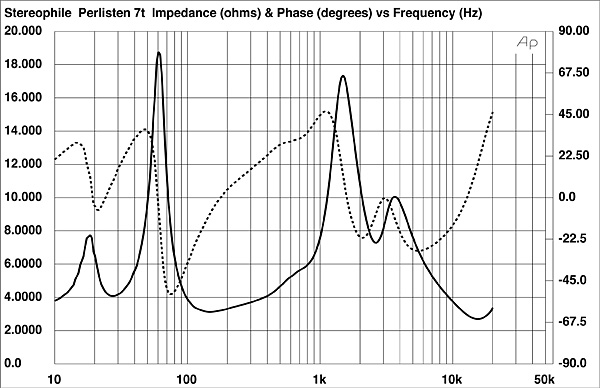
The traces in fig.1 are free from the small discontinuities in the midrange that would imply resonances of some kind. When I investigated the enclosure's vibrational behavior with a plastic-tape accelerometer, I found a couple of resonant modes in the midrange (fig.2). However, these are low in level and have a relatively high Q (Quality Factor), both of which imply that they will not affect sound quality.
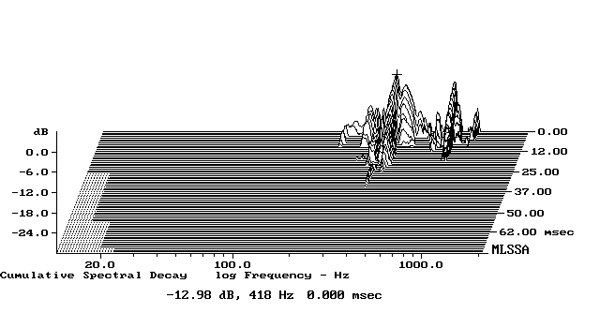
The saddle centered on 27Hz in the impedance magnitude trace suggests that this is the tuning frequency of the reflex-loaded woofers. The red trace in fig.3 shows the nearfield response measured at one of the vents at the speaker's base. There is a broad peak centered on 27Hz but also significant output in the midbass region before the response rolls off steeply above 80Hz. The blue trace below 350Hz is the summed nearfield response of the four woofers. Although the information sheet on Perlisten's website says that the woofers can be operated with the reflex ports open or closed, all four woofers behaved identically, with a minimum-motion notch at the port tuning frequency, which indicates that the ports were open. The boost in the upper bass is an artifact of the nearfield measurement technique, which assumes that the radiators are mounted in a true infinite baffle, ie, one that extends to infinity in both planes. When corrected for this, the woofer's upper- and mid-bass output will be flat.
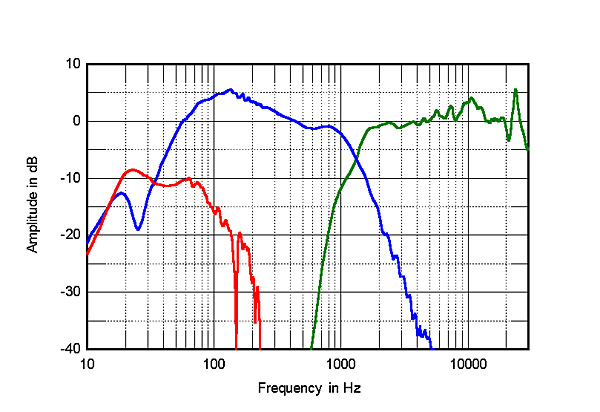
The blue trace above 350Hz in fig.3 shows the farfield response of the woofers. The woofers at the top and bottom of the front baffle start rolling off above 600Hz, but the two woofers closest to the DPC array cross over to the farfield output of the array (green trace) at 1.4kHz, with then a steep, 18dB/octave rolloff. The DPC array rolls in steeply with what appears to be a 24dB/octave slope. Its output is flat in the low and mid-treble, though a slight peak is apparent at 10kHz. The tweeter's fundamental dome response can be seen at 23.7kHz, safely above the audioband. Fig.4 shows the S7t's farfield response averaged across a 30° horizontal window centered on the tweeter axis. The nearfield bump in the upper bass is present, but overall the response is impressively even in the midrange through to 7kHz or so. There weren't any significant differences when I repeated this measurement with the grille covering the DPC array (not shown).
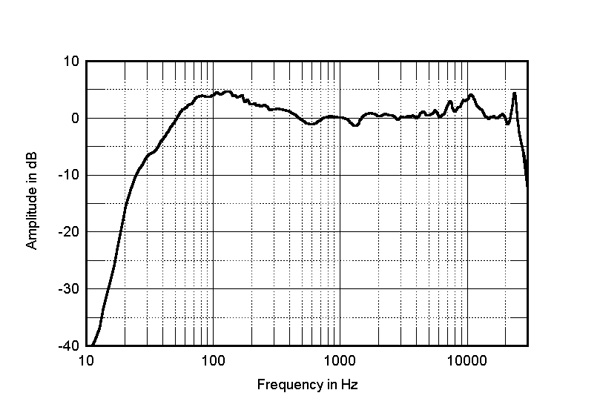
The S7t's horizontal dispersion is shown in fig.5. (The traces are normalized to the response on the tweeter axis, which thus appears as a straight line.) Other than a slight off-axis flare in the presence region, the loudspeaker's radiation pattern is smooth and even up to 6kHz. Above that frequency, the DPC array's radiation pattern starts to narrow, which might make the speaker sound a little airless in very large rooms. The Perlisten's vertical dispersion, again normalized to the response on the tweeter axis, is shown in fig.6. The loudspeaker's balance doesn't change appreciably over a wide ±10° window, though a suckout at the crossover frequency starts to develop 15° above the tweeter axis. Don't listen to this speaker while standing.
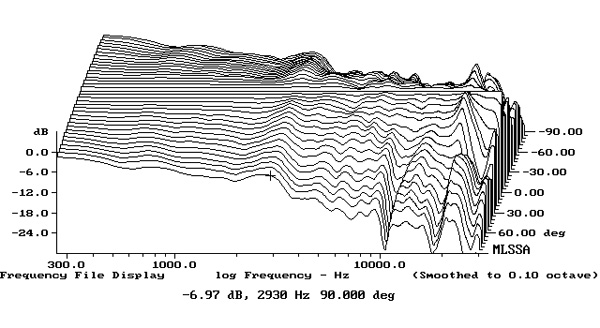
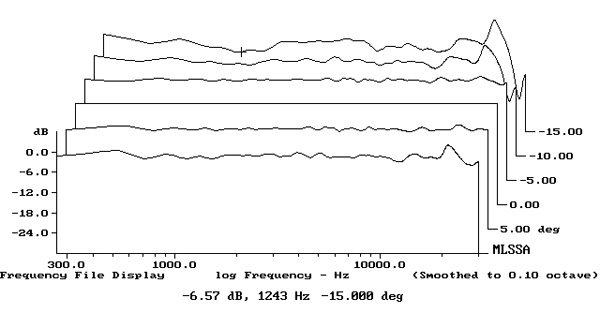
In the time domain, the S7t's step response on the tweeter axis (fig.7) reveals that all the drive-units are connected in positive acoustic polarity. The decay of the DPC array's step smoothly blends with the positive-going start of the woofers' step, which implies optimal implementation of the crossover filters. The S7t's cumulative spectral-decay plot (fig.8) is superbly clean, especially in the region covered by the DPC array.
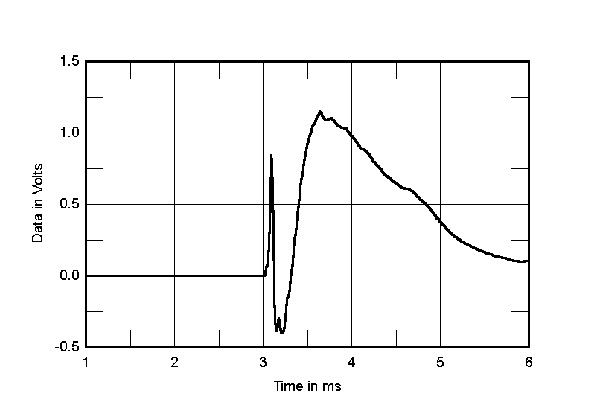
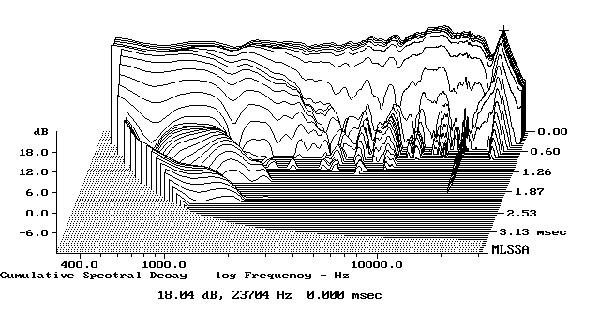
To say that I was impressed by the Perlisten S7t's measured performance would be an understatement. It typifies excellent loudspeaker engineering.—John Atkinson

I'll take the robot over any reviewer as long as Paul Seydor's wife Danielle says it desn't sound like hi-fi. Now I'm down to the age old question, will it play my reference albums and recordings?


The Kippel is an important tool to measure speakers. Kind of a shame Amir is the only reviewer using it.

The [Klippel] is an important tool to measure speakers. Kind of a shame Amir is the only reviewer using it.
While I have personally spent >$50k on test equipment over the years, the $100k the Klippel NearField Scannner costs is out of reach for me financially. :-(
There is also the fact that the Klippel needs to be used in a space with a 10' ceiling height, which is not feasible in my NYC home.
Nevertheless, I don't feel my loudspeaker measurements are lacking.
John Atkinson
Technical Editor, Stereophile

for a discussion of measuring techniques for loudspeakers. I'm going to use measurements from a Klippel when I can. I don’t use yours because I want to measure speakers myself. And of course, play my reference albums and recordings in an environment I control.
I recently acquired a new SUV and have heard six tracks from my reference albums in the last month. It will be an adventure to adjust the audio system to play them reasonably well.

also uses Klippel, but for what it's worth, JA's measurements do get the job done, except for maybe loudspeaker THD measurements.

vs Klippel is A little like Garry Kasparov vs Deep Blue. Deep experience vs pure processing power. Each obviously has their strengths and weaknesses.

Dont know who Amir is but Erin's Audio Corner has been using Klippel for his reviews.

Klippel's measurement systems are capable of many standard measurements including acoustic response (frequency, phase, impulse) but it is unique in offering additional measurements such as laser scanning, LSI (large signal nonlinearity testing), and distortion measurements including electromechanical DC offset. Those who work in the industry, myself included, will tell you that the specific measurements the Klippel system offers beyond the standard measurements Stereophile obtains by other means are meant to aid in the development of products, usually focusing on a specific transducer in the system (a woofer, midrange, or tweeter in isolation) but do not have direct correlation to what you as the listener will experience in the context of the fully integrated loudspeaker system. You do not hear the suspension symmetry of a loudspeaker, but you will hear its impact upon dynamic compression or harmonic distortion. You do not hear the breakup shape of a transducer diaphragm, but you hear its impact on the frequency and impulse response. You do not hear the offset of a transducer's BL curve, but you hear harmonic distortion and sensitivity loss from an out-of-magnetic-center voice coil. The more advanced Klippel tests can tell you a lot about a specific component of a speaker system, but when you look at the complete integrated system together (drivers, cabinet, crossover, porting) a lot of that information recedes into the background as minimally relevant. At most, you are checking the designer's work. The standard measurements performed by Stereophile are still the ones most directly linked to what you will hear.

Funny that the Klippel system found errors in Ocean Way's speakers that I heard as something is a little off at shows before Covid-19. And I don't know of many speakers that get past my nine reference albums and three reference recordings.

While it certainly seems possible that system of this size could be set up for bass extension to 20 Hz (-3dB), the designers apparently have made a choice to forego that in favor of a bit more efficiency. Given that most home listening environments have a 3 to 6 dB boost in the 40-50 Hz range, it's likely that, in-room, this speaker is "flat" to below 40 Hz. The result, according to Kal's report is plenty of bass power (undistorted, uncompressed loudness) achieving a sense of realism that most people want. As Mr. Austin's footnote advises, those wanting 20 Hz extension can always add a subwoofer or two (of equal dynamic capabilities to the main speakers) in order to hear the "hall sound" and other ULF. Given that most subs feature self-adjusting room correction, this probably would result in better sound than a totally passive, uncorrected single "full-range" system of equal LF extension.

.........uncorrected single "full-range" system of equal LF extension." quoted dc bruce.
Hi
IMO, SURELY not "probably".
My experience tells me active sub(s) when blended properly with any "full-range' loudspeaker system will surely improve its ULF than without.
I finally get back the music I missed soooo much before without my active subs installed!
Listening is believing
Jack L

No small feat competing well against your Revels. Also would you say it plays better ported or sealed?

Dunno. Only used them as ported, at the recommendation of the distributor/installer. Also, despite their supposed good accommodation for subs in the sealed configuration, a domestic speaker of this size would most likely be employed in stereo in most systems and would be expected to perform well without subs.

Thanks, Kal. How far from the front wall would you say is prudent?

??? Prudent in what way?

As far as I’m concerned John and Kal are among the best there is at what they do. They are in Elysium, which we can almost grasp but which enlightens us and helps us to be better. John will always be the standard by which all testers and their equipment are measured. I’ll take John’s meticulous approach, scientific consistency and sheer will over anybody else and the latest “Flux Capacitor” out there. John gets my lifetime vote as the Michelangelo of testing components and speakers. Kal consistently produces gem reviews with insight and music choices that unearth a speaker’s capabilities. We, as readers, get a frequent real treat from John, Kal and the rest of the Stereophile Audiophile Squad!

I’ll take John’s meticulous approach, scientific consistency and sheer will over anybody else . . .
Thank you. I appreciate your comments. About consistency: I have always felt that consistency of approach to testing and the presentation of the results is important. The loudspeaker tests in Stereophile feature a common format that allows a speaker's measured results from 30 years ago to be easily compared with those of current-day models.
John Atkinson
Technical Editor, Stereophile

Thank you for an amazing review about amazing speaker.
this one as all the bass needed .
the issue with sub woofer integration should be considered in every system and its not related (always) to fronts speakers extension or specific in room response( again - in terms of room gain)
sub or multiple subs - configured correctly will give a much smoother response .
thank you again

Hi
Hopefully the speakere driver units are NOT made in China as well !!!
Jack L

..are all made in China. They appear to be excellent performers.

Hi
Thanks but no thanks !!
US$20,000 USA brandname loudspeakers BUT 100% made-in-China ????
Glad Stereophile honestly pointed out its country of origin as no indication showing its manufacture location at the back panel of the loudspeaker.
IMO, what a very smart way of making audio consumers' money by building them in an OEM overshore cheap at the expense of the qualtiy consistency of the product.
Good luck !
Jack L

US$20,000 USA brandname loudspeakers BUT 100% made-in-China ????
If these same speakers were 100% made in USA (assuming that this would even be possible today), they probably would cost twice as much or more.
Glad Stereophile honestly pointed out its country of origin as no indication showing its manufacture location at the back panel of the loudspeaker.
Reporting country of origin has been our policy for some time.
IMO, what a very smart way of making audio consumers' money by building them in an OEM overshore cheap at the expense of the qualtiy consistency of the product.
How presumptuous.

Hi
So ??
When many digital fans can afford $10,000 +++ for a DAC, would they worry to spend $40,000 for a pair of front loudspeakers, a very major component of the home audio rig, made 100% in the country of origin?
Yes, quite a few loudspeakers manufacturers get their products assembled in China using wooden boxes built there (huge cost saving) but still using the critical components, e.g. speaker driver units & other electronic parts supplied by the original manufacturers. That's will restore the consumers confidence.
Likewise, I never own a car not built in its country of origin.
Jack L
PS: I fixed quite a few tube power amps built in China provided by my audio friends. I got good experience how good are China-built electronics.

That's will restore the consumers confidence.
What will instill (rather than restore) consumer confidence is the track record. Obsessive adhesion to "country of origin" is only a little piece of the puzzle.

Hi
My question as a consumer:-
Is the "track record" based on the loudspeakers made in USA or made by OEMs offshore ??????
Otherwise I would consider such "track record' INVALID without disclosing where the products are actually built.
There is no countdry of origin showing on the loudspeaker box. So why ???
Jack L

Is the "track record" based on the loudspeakers made in USA or made by OEMs offshore ??????
Neither. It is based on the loudspeakers of a particular manufacturer.
There is no countdry of origin showing on the loudspeaker box. So why ???
Take a closer look. On terminal panel on the back of the speaker, just above the terminals, it says "Designed and Engineered in the USA - Made in China"

Hi
"Presumptuous" !
Sorry. The picture showing the loudspeaker panel above only shows, in pretty fine letters: -
"& engineered in USA & made".
So you still assume we readers could presume it is made in China !!
Ironically, all other signs on the back panel, e.g. THX, Dominus, even
minor signs like RoHS & CE are so much larger in size to be seen so obvious.
"track record" - "Neither" ..
Please defne your meaning for "traack record" to avoid further confusion to naive consumers like yours truly.
Jack L

Now you are just being churlish. The country of origin was clearly indicated in the review. It is, also, printed on the back of the speaker and visible to anyone at a showroom, even if not completely so in our photography.
What is meant by track record? The most general meaning (from Oxford via Google):
the past achievements or performance of a person, organization, or product. "he has an excellent track record as an author"
Consider this my final reply to you.

Hi
"Churlish" !!
When I asked you how you determine the performance of the loudspeakers when they were made-in-China, you redirect the issue to something else: "track record".
So what is that to do with its geneeal meaning by Oxford.
Likewise when Bill Clinton's presidential career was ruined by his affair with his intern, so would YOU still take Bill's brillient performance in the past as 'excellent track record' ??
This is my last response to your non-answer to the above.
Jack L


The picture showing the loudspeaker panel above only shows, in pretty fine letters: - "& engineered in USA & made". So you still assume we readers could presume it is made in China !!
When I measure a product I always take a photo of the back panel and the box, showing the country of manufacture. Though my photos weren't included in the review, the Perlisten's terminal panel does indeed say "Made in China." This information is included in the review's Specifications sidebar.
John Atkinson
Technical Editor, Stereophile


I'll not be purchasing any equipment made in China.

No disrespect but I will wait for a more credible review before I seek these out for a demo.

If you doubt our credibility, you can easily find several other reviews out there but, of course, I cannot vouch for their credibility.

... a better way for 'Lee Robert' to have phrased that comment, rather than "wait for a more credible review."
Following is a link to another review (that includes a set of measurements) and their results essentially confirm the findings of KR, along with those of JA1.
https://www.audioholics.com/tower-speaker-reviews/perlisten-s7t


My remark was not to impugn other reviewers nor did I intend to provide links to other reviews but as directive in response to the implication that our review was less credible than other, yet undefined, reviews. They do exist and Mr. Robert should use Google to seek them out.

I can’t believe how many people engage in what the Brits would term “rather shirty” remarks just for attention. People the caliber of Kal and John have WAY better things to do then defend themselves from what radio announcers were forced to call “bullsch.” I read another article about the Perlisten S7t with testing. While a good and decent article, Stereophile is always the gold standard. It’s like comparing Double AA or Triple AAA baseball players to the Gods of Baseball, Sheesh! Long after the universe has shrunk to it’s last dying star, people will be saying about Stereophile reviewers, especially Kal and John, To add lib Aztec 2Step: There will never be a faster gun or another one like you are!
So to snarky readers here is what bikers would have to offer: Sit down, shut up, and hold on!

Reads to be an excellent speaker. However, as long as China continues to steal our (and other free-world country's) technology and manipulate their currency to undercut free/fair trade I'll not own anything made there when I can possibly avoid it. Why support our economic enemy who may in our lifetime become our military enemy?

I respect your position. These days, it is difficult to avoid products of complex technology that do not contain any component part from China.

Hi
I can't agree more. We are dealing with a major Communist
country, no kidding !!!!
Now quite a few free-world countries. led by USA, have already declared boycotting the Beijing Winter Olympic Games next year by not sending any
official delegates to its offical opening ceremony !! First in Olympic history ever !
Some countries even consider to stop sending over their athletes to the Game. Let' see !
Jack L

Yes. Absolutely true. I'm sure my new Pass INT-25 will have any number of lower-value parts made in China. As you state, impossible to avoid. But, when one has the choice.......... stick with the free-world when possible.

Bingo !!
Jack L

Has anyone besides me noticed the close similarity to the XA (expanding array) David Smith developed at Snell for the XA series back around the year 1999?
The bracketing of the mid-woofers, two mid-ranges and a dome tweeter in a waveguide looks very familiar to me. Even the stated design goals of the XA array echo what Perlisten is looking to achieve.
See this review in this very magazine...
https://www.stereophile.com/floorloudspeakers/334/index.html
I am going to compare the JA test results, as applicable, to look for similar measurement results. It should make for interesting reading.
And for the record, I am still the happy, original owner of a pair of XA90's. Thank you David!
And as far as 'Made In China" is concerned: I too will avoid purchasing high-dollar goods sourced there. My preference for solid, long term reliability and serviceability win out over price for high-dollar purchases.
And lastly, thanks to all the folks at Stereophile for a great publication.
HEO

Yep it reminded me of the the old Snell XA's. What it reminded me even more of was my own Infinity Composition Prelude P-FR's. The configuration is very similar but the craftsmanship on the Perlistens is just out of this world.
For those who talk of China, I understand buying USA, however most of the magnets in our speakers come from China, due to them having the metal that they're made from. Circuit boards, TV's, and more have Chinese materials in them. It's impossible to avoid in a modern world.
I'd also like to shout out a "Bravo Zulu" to Kal on his review. I trust his measurements, and they're verified by the spins that are included on the Perlisten site. I believe between Kal, and the other independent reviews out there, we have enough data to say these speakers measure well. If Amir can get his hands on a set, I believe he will come back with the same answer. As far as Perlisten goes....specs and data wise, I've seen enough - I'm a believer. Now only if I could get out of Audiophile prison and PERhaps LISTEN to a pair.

I've went back and looked at the measurements and I'm surprised at how close they are. Both have a recommendation that says "Dont listen to these speakers while standing", I found that quite amusing indeed!!!!

If one was to remove all the parts from everything we own that have any china sourcing we would have to walk to work barefoot and wouldn’t be responding to this review because wtf do you think your typing on?
These speakers look to have original thinking and solid engineering and I’m glad you guys found them then took the time to share them with us.

Great review, Kal.
In the upper bass difference you describe, would you say this area lies below the room transition frequency? If so, I wonder if this difference might have more to do with how each speaker interacted with your room, from their respective positions, and less to do with the speakers themselves? After all, many of us would be applying EQ below the room transition frequency anyways, so if that difference disappears after doing that, then I personally wouldn't put much weight on it anyways.
Also, I've read the these speakers are probably able to play much louder with less distortion than some other worthy competitors, such as your speakers or the 328be. But I wonder, in most rooms, would that extra ability actually provide a real added benefit, or would you need an extremely large room for that benefit to be aparent?
Thanks.